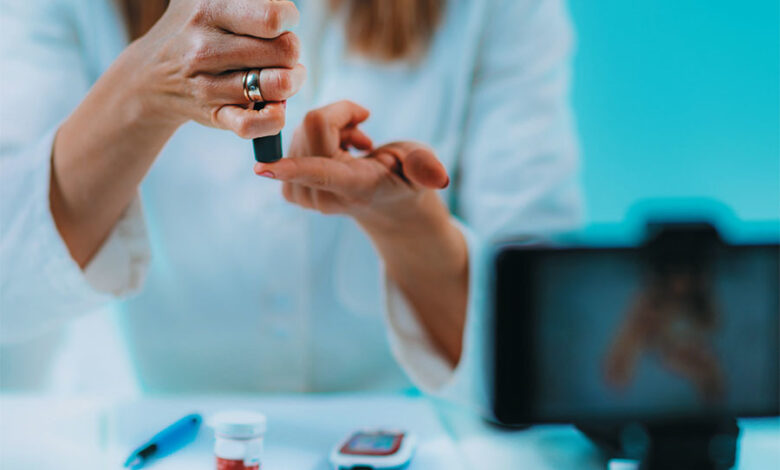
Maximizing The Role Of Telehealth In Managing Diabetes
BY , BSN, RN, CDCES
When I first transitioned to remote nursing, it was a major change from front-line cardiac critical care nursing. One evening at the beginning of my shift, the day nurse was giving me a report and telling me she was starting a new job on Monday to start working from home as a nurse. I chuckled and looked at her side-eyed as I updated my notes for the night, saying, “That’s not a job…you can’t be a nurse and work from home, unless it’s home health or something…” I was bewildered that this even existed. As the daughter of a nurse, who was born at the same hospital she worked at for over 40 years, my image of nursing was of one at the bedside carrying out provider’s orders and providing comfort to clients and their families in the same space.
A few months later, that same nurse and I were catching up, and she said they were looking for a nurse with a cardiac critical care background to be a Care Coach for the chronic disease management program, focusing on coronary artery disease and congestive heart failure. I was a new mom and ready for a professional position that would be more accommodating to this life stage and took the plunge into telehealth/remote nursing. After training at the main office, I found myself at home and noticed a trend of how many of my cardiac clients had diabetes as a comorbidity. Suddenly, clients were asking about different classes of medications for diabetes management (including different types of insulins I hadn’t thought of since nursing school). I was missing the comfort and familiarity of an insulin drip at 2 a.m. with my post-heart surgery clients, coupled with the fact I no longer could rely on my trusted physical assessment skills. I went from the most acute care setting to chronic disease management in my home, and I was experiencing whiplash from the ride.
I proposed to the leadership team at my organization the opportunity for me to earn my Certified Diabetes Educator (now called Certified Diabetes Care and Education Specialist), and they fully supported me in this journey. As I studied for that exam, my eyes were open to the stunning and complicated pathogenesis that is associated with diabetes that influences clinical outcomes and the different types of medications, where and how they work in the body, and special considerations when teaching these clients about their medications depending on their comorbidities and clinical history. During this time, I was coaching mainly cardiac clients and oftentimes their initial diabetes diagnosis is at a time of a major medical event.
As a telehealth nurse I have the unique privilege to speak with clients and their caregivers after the initial dust settles from their medical event, on their terms. The relationships and rapport that can be built this way are truly breathtaking. Oftentimes you find yourself as the first clinician holding the emotional space and breaking down what the provider has shared with them and can assess their feelings and possible knowledge gaps regarding medical events, self-management strategies, and influencing factors. Once rapport is established, you’re able to explore the client’s feelings around their self management strategies and coping techniques, including collaborating with their treating providers.
The case manager acts as the wireless internet router within the healthcare ecosystem. Oftentimes, we are the ones identifying key pieces of information and own the professional and ethical responsibility that comes with notifying key players in the healthcare team and identifying possible solutions or additional support to help the client achieve self-management of diabetes. We are usually the ones to first identify the barriers identified for the client reaching their optimal level of disease control and wellness. The case manager may be able to identify additional telehealth benefits available to the client by reviewing their medical and pharmacy benefit information to see what other healthcare provider support is available to them for gaps in care management. The American Diabetes Association releases their yearly Standards of Care to help clinicians with optimal management of this disease. This framework is helpful when evaluating what other healthcare providers could provide additional support for the client. It’s also important for the staff developing the framework to evaluate their clinical decision-making tools, assessments, education and knowledge gap analysis yearly.
THE ROLE OF DIABETES DISTRESS IN CLIENT DECISION MAKING
It’s helpful when first making contact with the client to review what current and potential stressors will be influencing their decision making when it comes to diabetes management. Diabetes stress and other psychosocial influencing factors will directly influence how the client perceives and manages their condition. It’s impossible to teach someone about the complicated physiological response that is happening with diabetes when their primary concern is affording food or their current life stressors are the most pressing matter in their life. One of the gifts of telehealth in my experience is the privilege of people openly sharing their thoughts, feelings and past personal experiences about diabetes from their family/friends, and the biggest revealer of all is their relationship with food/dieting in the past. For many clients, they have years of an inner story they’ve been telling themselves of guilt/shame experiences with certain food groups in combination with new shame for a new diabetes diagnosis based on societal influence. In small, bite-size conversations, the diabetes educator can help them understand gut hormones and how they are suppressed when you have diabetes, which may make them feel like they are never fully satiated or crave certain types of foods only that make it difficult to reach their blood sugar goals and weight management goals. Leveraging motivational interviewing and SMART goal setting can help the client build that confidence in managing their condition. Another option is to explore the client’s feelings of accessing mental health/counseling from any other available telehealth benefits depending on their payor source. It can be helpful to contact their benefits department and inquire for telehealth counseling benefit information or any employee assistance programs that may be available.
EVALUATING BEST PRACTICES BASED ON LEVEL OF CARE
When considering the best application of telehealth/chronic disease management, it will depend on your client population, invested stakeholders, your own professional roles/responsibilities, and your place within the healthcare ecosystem. It’s important to start with the survey of the population you want to serve. The clinician’s priorities may be different than the client population you are wanting to serve. Identifying their main barriers will help you in deciding the first steps toward implementation. It must be a needs-driven approach when planning/implementing and evaluating your telehealth program. The key piece to consider is how can we reduce any client-reported pain points by appropriately leveraging technology for success. Your front-line staff/team should be able to complete basic tech support in order to facilitate the telehealth process. In the event they are not able to assist, you must have a system in place for feedback to be provided to all stakeholders in the process; this will include both clinical and information technology.
To maximize your time on this platform, evaluate opportunities for non-clinical staff to engage with the client to allow your clinicians to operate at the top of their credentialed licenses. The COVID-19 pandemic fast tracked not only the availability of reimbursable telehealth services due to the limited availability of in-person care, but also the use of digital health tools and remote client monitoring systems and the different healthcare systems responses to the virus and the need for limited physical exposure/contact.
PRIVACY CONCERNS AND SAFETY PROTOCOLS
With the increase in cyberattacks, ransomware, and more discussions of “big data” and digital privacy in technology/social media use, it’s important to prepare the front-line case managers, and the leadership team will need to collaborate and maintain open lines of communication for feedback with their HIM/IT teams for the most secure, accessible, and equitable user experience possible. For example, one of my clients was trying to use her provider’s client portal; the problem was, when she went to send a message, there was a required field for location that had to be entered by the office staff in order to send this message. This step wasn’t completed during her onboarding process at the provider’s office so she wasn’t able to use the tool as planned. It’s important to have a system or protocol in place for these user-reported issues to be addressed. Additionally, it’ll be helpful to ask yourself where within the in-person touch points you have with clients to demonstrate and increase exposure of the tool to increase the chance of engagement when used remotely. Another key piece to consider is how do you evaluate which safety protocols you need and have in place in order to successfully roll out this tool. What will your staff do if they identify an imminent risk of health and safety of the client or public, while utilizing the telehealth tool? Do they have the training, support, framework in place to swiftly identify, intervene and follow up accordingly for these interactions? Their response/interventions will look different from direct/in-person care and vary depending on your practice area.
2020 brought an immense expansion of digital health tools, telehealth frameworks and reimbursement policies from CMS. As we enter 2021, it’s important to remember having all of these data/readings is not enough for optimal glucose control. We’re seeing advancements in artificial intelligence and machine learning to augment patient care, but all of these tools, no matter how sophisticated, will require clinical champions to notify all stakeholders to bridge the gap between technology and the user experience. Case managers carry a large responsibility on their shoulders as they help guide clients and families through the healthcare system, but they also have that direct engagement that will provide feedback regarding how useful the tool is in real time, highly valuable recommendations/enhancements, and maximizing the impact of the integration with possible future digital health tools as we see an expansion in interoperability rules and regulations.





